CHAPTER XII, Part TWO
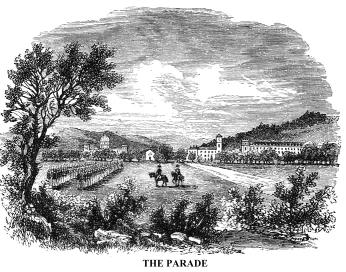 Kosciuszko
was much beloved by the Revolutionary Army, and his memory is held in reverence
by the American people. He was only twenty years of age when he joined that
army. He had been educated at the Military School of Warsaw. He had not completed
his studies, when he eloped with a beautiful girl of high rank. They were
overtaken by the maiden's father, who made a violent attempt to seize his
daughter. The young Pole was compelled either to slay the father or abandon
the daughter. He chose the latter, and obtaining the permission of his sovereign,
he went to France, and there became a student in drawing and military science.
In Paris he was introduced to Dr. Franklin, and, fired with a desire to aid
a people fighting for independence, he sailed for America, bearing letters
from that minister. He applied to Washington for employment. "What do
you seek here?" asked the leader of the armies of the revolted colonies.
"I come to fight as a volunteer for American independence," the
young Pole replied. "What can you do?" Washington asked. "Try
me," was Kosciuszko's prompt reply. Pleased with the young man, Washington
took him into his military family. The Congress soon afterwards appointed
him engineer, with the rank of colonel. He returned to Poland at the close
of the Revolution, and was made a major-general under Poniatowski. He was
at the head of the military movements of the Revolution in Poland, in 1794,
and was made a prisoner, and carried to St. Petersburg. This event caused
Campbell to write--
Kosciuszko
was much beloved by the Revolutionary Army, and his memory is held in reverence
by the American people. He was only twenty years of age when he joined that
army. He had been educated at the Military School of Warsaw. He had not completed
his studies, when he eloped with a beautiful girl of high rank. They were
overtaken by the maiden's father, who made a violent attempt to seize his
daughter. The young Pole was compelled either to slay the father or abandon
the daughter. He chose the latter, and obtaining the permission of his sovereign,
he went to France, and there became a student in drawing and military science.
In Paris he was introduced to Dr. Franklin, and, fired with a desire to aid
a people fighting for independence, he sailed for America, bearing letters
from that minister. He applied to Washington for employment. "What do
you seek here?" asked the leader of the armies of the revolted colonies.
"I come to fight as a volunteer for American independence," the
young Pole replied. "What can you do?" Washington asked. "Try
me," was Kosciuszko's prompt reply. Pleased with the young man, Washington
took him into his military family. The Congress soon afterwards appointed
him engineer, with the rank of colonel. He returned to Poland at the close
of the Revolution, and was made a major-general under Poniatowski. He was
at the head of the military movements of the Revolution in Poland, in 1794,
and was made a prisoner, and carried to St. Petersburg. This event caused
Campbell to write--
"Hope for a season bade the earth farewell,
And freedom shrieked when Kosciuszko fell."
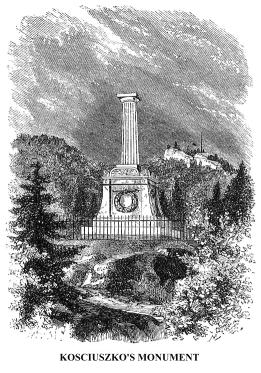 After the Empress Catherine died, the Emperor Paul liberated him, offered
him command in the Russian service, and presented him with his own sword.
He declined it, saying, "I no longer need a sword, since I have no longer
a country to defend." He revisited the United States in 1797, when the
Congress granted him land in consideration of his services. He afterwards
lived in Switzerland, and there he died in 1817. A public funeral was made
for him at Warsaw. Twelve years afterwards, the cadets of West Point, actuated
by love for the man and reverence for his deeds, erected a beautiful marble
monument to his memory, within the ruins of Old Fort Clinton, at a cost of
about $5,000. It bears upon one side the name of--" Kosciuszko ,"
and on another, the simple inscription--" Erected by the Corps of Cadets
, 1828." It is a conspicuous and pleasing object to voyagers upon the
river.
After the Empress Catherine died, the Emperor Paul liberated him, offered
him command in the Russian service, and presented him with his own sword.
He declined it, saying, "I no longer need a sword, since I have no longer
a country to defend." He revisited the United States in 1797, when the
Congress granted him land in consideration of his services. He afterwards
lived in Switzerland, and there he died in 1817. A public funeral was made
for him at Warsaw. Twelve years afterwards, the cadets of West Point, actuated
by love for the man and reverence for his deeds, erected a beautiful marble
monument to his memory, within the ruins of Old Fort Clinton, at a cost of
about $5,000. It bears upon one side the name of--" Kosciuszko ,"
and on another, the simple inscription--" Erected by the Corps of Cadets
, 1828." It is a conspicuous and pleasing object to voyagers upon the
river.
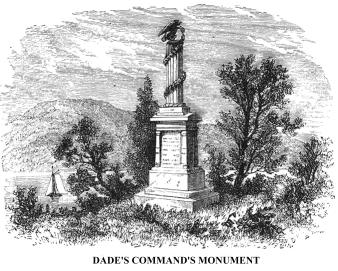 Passing
along the verge of the cliff, southward from Kosciuszko's monument, the visitor
soon reaches another memorial stone. It is of white marble, the chief member
being a fluted column, entwined by a laurel wreath, held in the beak of an
eagle, perched upon its top. The pedestal is of temple form, square, with
a row of encircling stars upon its entablature, and a cannon, like a supporting
column, at each corner. It was erected to commemorate a battle fought between
a detachment of United States troops, under Major Francis L. Dade, and a party
of Seminole Indians, in the Everglades of Florida, on the 28th of December,
1835. The detachment consisted of one hundred and eight men, all of whom,
save three, were massacred by the savages on that occasion. The troops nobly
defended themselves, and made no attempt to retreat. Their remains repose
near St. Augustine, in Florida. This monument was erected by the three regiments
and the medical staff, from which the detachment was selected.
Passing
along the verge of the cliff, southward from Kosciuszko's monument, the visitor
soon reaches another memorial stone. It is of white marble, the chief member
being a fluted column, entwined by a laurel wreath, held in the beak of an
eagle, perched upon its top. The pedestal is of temple form, square, with
a row of encircling stars upon its entablature, and a cannon, like a supporting
column, at each corner. It was erected to commemorate a battle fought between
a detachment of United States troops, under Major Francis L. Dade, and a party
of Seminole Indians, in the Everglades of Florida, on the 28th of December,
1835. The detachment consisted of one hundred and eight men, all of whom,
save three, were massacred by the savages on that occasion. The troops nobly
defended themselves, and made no attempt to retreat. Their remains repose
near St. Augustine, in Florida. This monument was erected by the three regiments
and the medical staff, from which the detachment was selected.
A few feet from Dade's Command's Monument, a narrow path, through
a rocky passage, overhung with 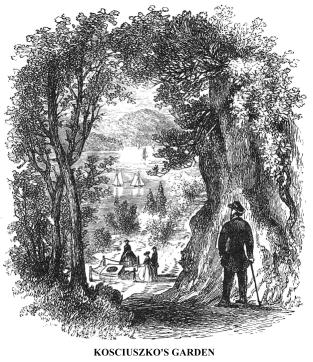 boughs
and shrubbery, leads down to a pleasant terrace in the steep bank of the river,
which is called Kosciuszko's Garden. At the back of the terrace the rock rises
perpendicularly, and from its outer edge descends as perpendicularly to the
river. This is said to have been Kosciuszko's favorite place of resort for
reading and meditation, while he was at West Point. He found a living spring
bubbling from the rocks, in the middle of the terrace, and there he constructed
a pretty little fountain. Its ruins were discovered in 1802, and repaired.
The water now rises into a marble basin. Seats have been provided for visitors,
ornamental shrubs have been planted, and the whole place wears an aspect of
mingled romance and beauty. A deep circular indentation in the rock back of
the fountain was made, tradition affirms, by a cannon-ball sent from a British
ship, while the Polish soldier was occupying his accustomed loitering place,
reading Vauban, and regaled by the perfume of roses. From this quiet, solitary
retreat, a pathway, appropriately called Flirtation Walk, leads up to the
plain.
boughs
and shrubbery, leads down to a pleasant terrace in the steep bank of the river,
which is called Kosciuszko's Garden. At the back of the terrace the rock rises
perpendicularly, and from its outer edge descends as perpendicularly to the
river. This is said to have been Kosciuszko's favorite place of resort for
reading and meditation, while he was at West Point. He found a living spring
bubbling from the rocks, in the middle of the terrace, and there he constructed
a pretty little fountain. Its ruins were discovered in 1802, and repaired.
The water now rises into a marble basin. Seats have been provided for visitors,
ornamental shrubs have been planted, and the whole place wears an aspect of
mingled romance and beauty. A deep circular indentation in the rock back of
the fountain was made, tradition affirms, by a cannon-ball sent from a British
ship, while the Polish soldier was occupying his accustomed loitering place,
reading Vauban, and regaled by the perfume of roses. From this quiet, solitary
retreat, a pathway, appropriately called Flirtation Walk, leads up to the
plain.
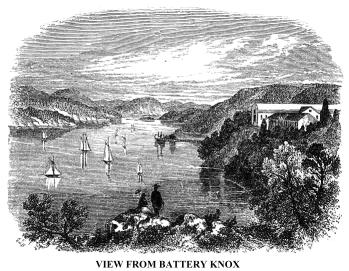 A
short distance from Kosciuszko's Garden, upon a higher terrace, is Battery
Knox, constructed by the cadets. It commands a fine view of the eastern shore
of the Hudson, in the Highlands, and down the river to Anthony's Nose. Near
by are seen the Cavalry Stables and the Cavalry Exercise Hall, belonging to
the Military School; and below there is seen the modern West Point Landing.
A little higher up, on the plain, are the groups of spacious edifices, used
for the purposes of the institution.
A
short distance from Kosciuszko's Garden, upon a higher terrace, is Battery
Knox, constructed by the cadets. It commands a fine view of the eastern shore
of the Hudson, in the Highlands, and down the river to Anthony's Nose. Near
by are seen the Cavalry Stables and the Cavalry Exercise Hall, belonging to
the Military School; and below there is seen the modern West Point Landing.
A little higher up, on the plain, are the groups of spacious edifices, used
for the purposes of the institution.
West Point was indicated by Washington, as early as 1783, as an eligible place for a military academy. In his message to the Congress in 1793, he recommended the establishment of one at West Point. The subject rested until 1802, when Congress made provision by law for such an institution there. Very little progress was made in the matter until the year 1812, when, by another act of Congress, a corps of engineers and professors were organized, and the school was endowed with the most attractive features of a literary institution, mingled with that of a military character. From that time until the present, the academy has been increasing in importance, as the nursery of army officers and skilful practical engineers.
The buildings of the West Point Military Academy consisted, at the time we are considering, of cadets' barracks, cadets' guard-house, academy, mess hall, hospital of cadets, chapel, observatory, and library, artillery laboratory, hospital for troops, equipments shed, engineer troops' barracks, post guard-house, dragoons' barracks, artillery barracks, cavalry exercise hall, cavalry stables, powder magazine, the quarters of the officers and professors of the Academy, workshops, commissary of cadets and sutlers' store, shops and cottages for the accommodation of noncommissioned officers and their families, laundresses of the cadets, &c. The principal edifices are built of granite.
The post is under the general command of a superintendent, who hears the rank of brevet-colonel. The average number of cadets was about two hundred and fifty. Candidates for admission are selected by the War Department at Washington city, and they are required to report themselves for examination to the superintendent of the academy between the first and twentieth day of June. None are admitted who are less than sixteen or more than twenty-one years of age, who are less than five feet in height, or who are deformed or otherwise unfit for military duty. Each cadet, on admission, is obliged to subscribe his name to an agreement to serve in the army of the United States four years, in addition to his four years of instruction, unless sooner discharged by competent authority.
The course of instruction consists of infantry tactics and military policy, mathematics, the French language, natural philosophy, drawing, chemistry, mineralogy, artillery tactics, the science of gunnery and the duties of a military laboratory, engineering and the science of war, geography, history and ethics, the use of the sword, and cavalry exercise and tactics. The rules and regulations of the academy are very strict and salutary, and the instruction in all departments is thorough and complete.
The road from the plain to the landing at West Point was cut from the steep rocky bank of the river, at a heavy expense to the government. The wharf is spacious, and there a sentinel was continually posted, with a slate and pencil, to record the names of all persons who arrive and depart. This was for the use of the Superintendent, by which means he is informed daily of the arrival of any persons to whom he might wish to extend personal or professional courtesies.
A steam ferry-boat connects West Point with the Garrison Station
of the Hudson River Railway, 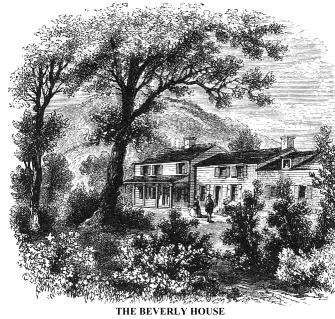 opposite.
Near the latter is the old ferry-place of the Revolution, where troops crossed
to and from West Point. Here Washington crossed on the morning when General
Arnold's treason was discovered, and here he held a most anxious consultation
with Colonel Hamilton when that event was suspected.
opposite.
Near the latter is the old ferry-place of the Revolution, where troops crossed
to and from West Point. Here Washington crossed on the morning when General
Arnold's treason was discovered, and here he held a most anxious consultation
with Colonel Hamilton when that event was suspected.
We crossed the ferry to Garrison's, and from the road near the station obtained a pleasant view of West Point, glimpses of the principal buildings there, and the range of lofty hills beyond, which form the group of the Cro' Nest and the Storm King. Following a winding road up the east bank of the river from this point, we came to a mill, almost hidden among the trees at the head of a dark ravine, through which flows a clear mountain stream, called Kedron Brook, wherefore, I could not learn, for there is no resemblance to Jerusalem or the Valley of Jehoshaphat near. It is a portion of the beautiful estate of Ardenia, the property of Richard Arden, Esq. His son, Lieutenant Thomas Arden, a graduate of the West Point Military Academy, owns and occupies Beverly, near by, the former residence of Colonel Beverly Robinson (an eminent American loyalist during the war for independence), and the head-quarters of General Benedict Arnold at the time of his treason. It is situated upon a broad and fertile terrace, at the foot of Sugar-Loaf Mountain, one of the eastern ranges of the Highlands, which rises eight hundred feet above the plain.
Copyright © 1998, -- 2004. Berry Enterprises. All rights reserved. All items on the site are copyrighted. While we welcome you to use the information provided on this web site by copying it, or downloading it; this information is copyrighted and not to be reproduced for distribution, sale, or profit.